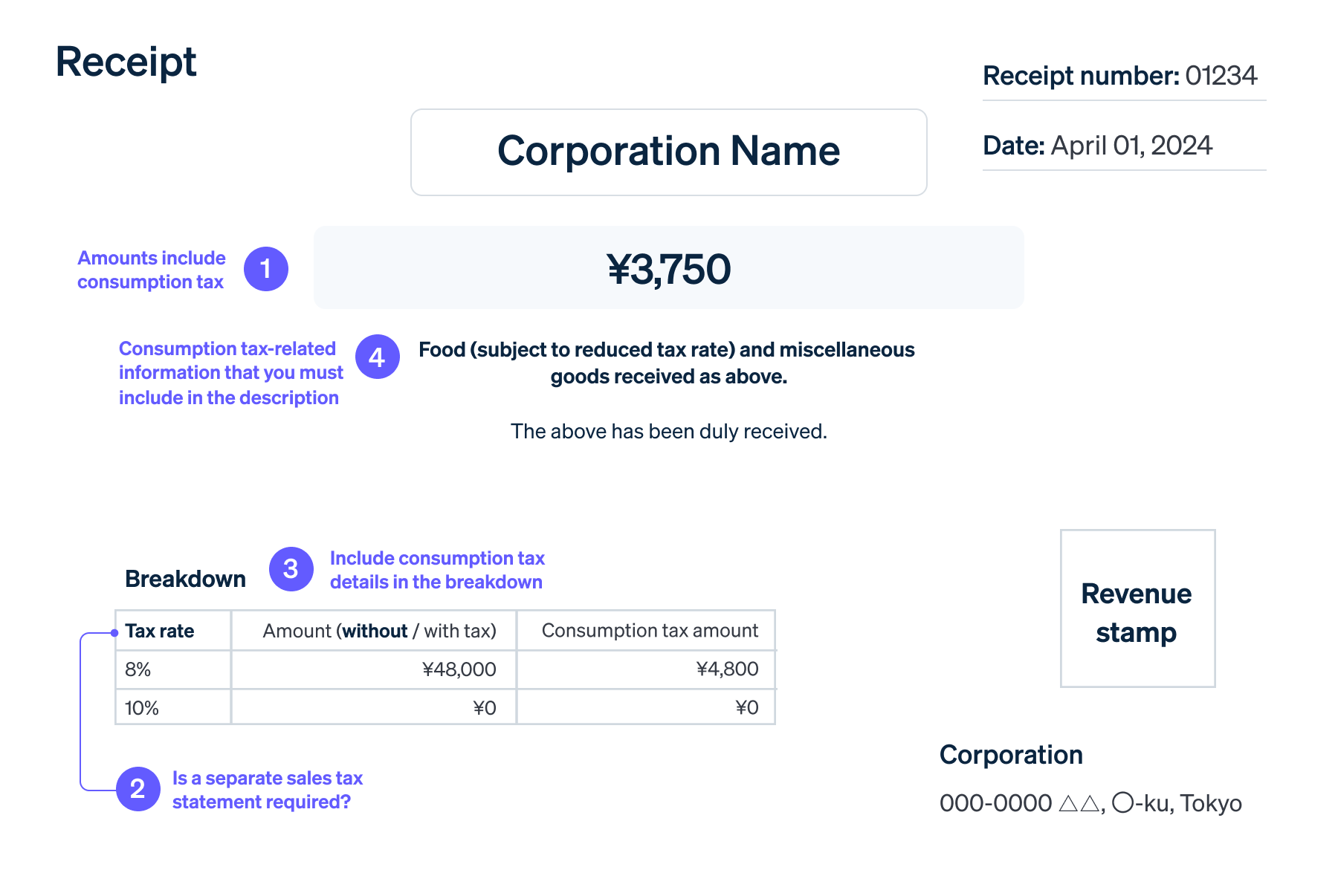卖方向买方出具一份名为收据的文件,以证明金钱或其他物品的交易。
收据通常包含开票公司(卖方)的名称、付款方(买方)的名称、开票日期(交易日期)、购买明细和支付金额。在收据中正确标示商品和服务的消费税是非常重要的。
本文将说明如何在收据中记录消费税及其他信息。
目录
- 收据创建基础知识
- 开具收据前需要了解的消费税事项
- 如何在收据中标示消费税及其他细节
- 与时俱进
收据创建基础知识
收据通常包含日期、金额、商品或服务明细、地址、分项信息等。收据没有固定模板,任何格式都可以,只要能清晰、直观地呈现必要数据,且客户可以理解即可。然而,为防止错误或篡改,在准备收据时需要注意以下几点:
收据是购买和付款的证明文件,也是税务申报所需的重要文件。因此,准确记录收据上的信息并妥善管理和存储至关重要。
收据上显示的总金额会影响税务申报中的扣除额。为了确保报税时没有错误或遗漏,您需要了解是否应在收据中包含与此金额相关的消费税,以及如何显示这些信息。
另一个重要点是新的合格账单制度。如果您将收据作为合格账单出具,则必须符合简化账单的要求(根据业务类型,税务机关将其视为简化账单)。
有关当前账单制度下如何出具收据的更多信息,请参阅文章“收据在账单制度中的作用及收据的出具方式”。
出具收据前需要了解的消费税事项
日本目前有两种消费税税率:8% 和 10%。这基于政府在 2019 年 10 月税改中将税率提高至 10% 时引入的优惠税率系统。其中,优惠税率为 8%。
企业在处理商品和服务时,必须应对多种税率。申请进项税额扣除是企业需要特别注意这些税率的原因之一。
要获得进项税额扣除,公司必须提供并保存符合账单制度要求的文件,并清楚标示适用的税率(有关合格账单及简化账单所需信息,请参阅日本国税厅发布的“合格账单保存方式概要第 5 页”)。
在日本,理解消费税的标准税率和优惠税率,以及在制作收据时如何考虑多种税率是十分重要的。
以下部分将介绍在收据中标示消费税时需要注意的一些关键点。
如何在收据中标示消费税及其他细节

1. 金额需包含消费税
收据上显示的金额必须始终包含税款,并为买方支付的总额。因此,需要在第③点的“分项信息”中,明确标示未税金额及销售税。
在输入金额时,无论是手写还是数字化,请确保每个数字以“¥”开头,末尾以“ー”结尾;每三位数字用逗号分隔;这有助于防止篡改。避免符号与数字之间留出过多空隙。
金额栏示例:
- ¥30,000 ー
2. 是否需要单独列出消费税
卖方通常根据“含税”价格在收到付款后开具收据。
然而,收据并不强制要求单独列出消费税,因此即使未标示,也不会受到法律处罚。
但为了避免可能的问题和误解,最好在收据中标明未税价格、消费税金额及商品总价(含税)。
如果根据账单制度的要求,收据未披露消费税金额,购买方企业可能无法申请进项税额扣除,从而导致交易无效。
因此,重要的是在收据中按照账单制度的规定标明消费税,以便于企业之间的采购交易顺利进行。
3. 在“细分”部分列明消费税详情
“细分”通常包括各税率(8% 和 10%)对应的总金额。总金额可以选择“含税”或“不含税”形式,但将不含税金额与消费税金额分开会更易理解。可单独列出交易金额的细分明细。
根据账单制度,自其启动以来,作为合格账单开具的收据必须明确列示支付总金额(不含税或含税)、适用的税率(8% 或 10%)、各税率分别对应的消费税金额。
消费税明细示例(付款金额计算):
10% 税率:
不含税 ¥50,000
消费税 ¥5,0008% 税率:
不含税 ¥10,000
消费税 ¥800
4. 在描述中注明与消费税相关的信息
描述部分通常需要说明用途。必须明确指出任何适用优惠税率的商品或服务。请注意,如果描述为空白或仅写“商品费用”,税务机关不会将其视为凭证文件,因为无法验证交易详情,可能导致无法将其作为费用入账。
如果是合格或简易账单,必须注明是否适用优惠税率。
描述示例
- 食品(适用优惠税率)及上述列出的杂货品。
- * 适用优惠税率
由于典型收据上的空间可能有限,因此描述可能很简短,如上面的第一个示例所示。若商品受优惠税率影响,请在括号中注明“适用优惠税率”。
对于同时购买不同税率商品的情况,可使用符号(如“*”或“☆”)标注优惠税率商品,并在单独框内注明具体信息,例如商品名称、数量及未税单价。
- 产品 A*:1 件, ¥1,000
- 产品 B:1 件, ¥2,000
与时俱进
本文介绍了如何在准备收据时管理消费税。自税务机关引入消费税以来,其税率稳步上升,并且系统可能会进一步修订。
企业必须关注系统和政策的最新动态,以适应税率的变化。
在线工具提供可自定义的收据模板和自动生成功能,可用于高效创建收据。此外,您可能需要考虑引入自动税额计算功能以及能够根据需求定制的会计软件。
Stripe 提供的 Stripe Tax 可自动识别并反映不同商品的 8% 或 10% 税率,实现所有电子交易的税务处理自动化,从而提高效率。这有助于优化和简化与消费税相关的各种后台运营。
Stripe Payments 支持多种账单支付方式,能够满足从支付受理到信息处理和收入管理的一站式交易需求。
本文中的内容仅供一般信息和教育目的,不应被解释为法律或税务建议。Stripe 不保证或担保文章中信息的准确性、完整性、充分性或时效性。您应该寻求在您的司法管辖区获得执业许可的合格律师或会计师的建议,以就您的特定情况提供建议。